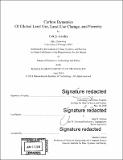| dc.contributor.advisor | John D. Sterman. | en_US |
| dc.contributor.author | Landry, Erik S. (Erik Sean) | en_US |
| dc.contributor.other | Technology and Policy Program. | en_US |
| dc.date.accessioned | 2018-09-17T15:49:59Z | |
| dc.date.available | 2018-09-17T15:49:59Z | |
| dc.date.copyright | 2018 | en_US |
| dc.date.issued | 2018 | en_US |
| dc.identifier.uri | http://hdl.handle.net/1721.1/117919 | |
| dc.description | Thesis: S.M. in Technology and Policy, Massachusetts Institute of Technology, School of Engineering, Institute for Data, Systems, and Society, 2018. | en_US |
| dc.description | Cataloged from PDF version of thesis. | en_US |
| dc.description | Includes bibliographical references (pages 33-36). | en_US |
| dc.description.abstract | Forest harvest for bioenergy is growing rapidly, spurred by the European Commission's declaration that bioenergy is carbon-neutral. Bioenergy advocates argue that the carbon released upon the combustion of harvested wood should eventually be reabsorbed from the atmosphere when the harvested land regrows. Recent studies, however, find that wood bioenergy can exacerbate climate change because it is less efficient than the fossil fuels it displaces, and because regrowth takes time and is uncertain. Other land use, land-use change, and forestry (LULUCF) practices can also cause significant carbon fluxes to and from the atmosphere that vary over time as the carbon sequestered in the biomass and soils on each land type changes. Understanding these complex interactions requires an explicit dynamic model that accounts for various land uses and regions, each with carbon content and flux characteristics specific to their respective vegetation, soil distributions, and climatic domains. This work extends the widely used C-ROADS climate model, originally developed with a single biosphere, to incorporate this level of detail. Built up from a diverse set of highly resolved geospatial databases for land cover, soils, climatic domains, and other relevant characteristics, the model aggregates the data into six land use types (natural forest, harvested forest, cropland, pasture, permafrost, and developed/other land) within six major regions (the US, EU, China, India, Other Developed Nations, and Other Developing Nations). It is used to analyze the impact of harvesting forests for bioenergy. Because wood bioenergy is less efficient than the fossil fuels it displaces, the first impact is an increase in atmospheric CO₂ . If the land regrows as forest, this carbon debt can eventually be repaid. However, the time required to do so is long, ranging from 20 to 186 years, depending on the region supplying the wood and whether the forest is thinned or clear-cut. Converting forest to cropland after harvest increases atmospheric CO₂ concentrations without payback. Results also show that afforestation programs are most effective in reducing atmospheric CO₂ when implemented in regions with more tropical climates due to the higher carbon density of these forests. This fast, regionally specific, multi-land-use model enables policy makers and other stakeholders to quickly design and evaluate of a wide range of LULUCF and bioenergy policy scenarios and their climatic effects. | en_US |
| dc.description.statementofresponsibility | by Erik S. Landry. | en_US |
| dc.format.extent | 84 pages | en_US |
| dc.language.iso | eng | en_US |
| dc.publisher | Massachusetts Institute of Technology | en_US |
| dc.rights | MIT theses are protected by copyright. They may be viewed, downloaded, or printed from this source but further reproduction or distribution in any format is prohibited without written permission. | en_US |
| dc.rights.uri | http://dspace.mit.edu/handle/1721.1/7582 | en_US |
| dc.subject | Institute for Data, Systems, and Society. | en_US |
| dc.subject | Engineering Systems Division. | en_US |
| dc.subject | Technology and Policy Program. | en_US |
| dc.title | Carbon dynamics of global land use, land-use change, and forestry | en_US |
| dc.type | Thesis | en_US |
| dc.description.degree | S.M. in Technology and Policy | en_US |
| dc.contributor.department | Massachusetts Institute of Technology. Engineering Systems Division | |
| dc.contributor.department | Massachusetts Institute of Technology. Institute for Data, Systems, and Society | |
| dc.identifier.oclc | 1051222996 | en_US |
